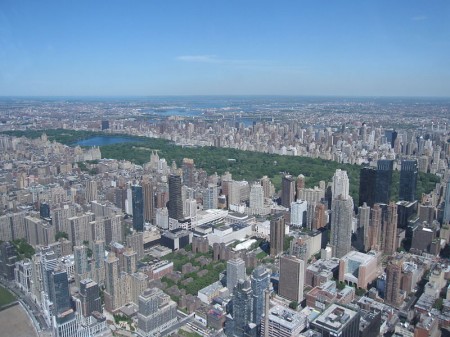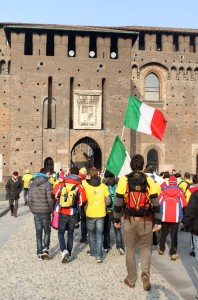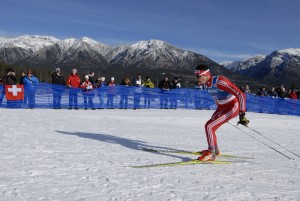Hans Karlsen has an audacious vision. He wants to stage a World Cup sprint in New York City’s Central Park.
Karlsen is no dewy-eyed newbie. Emigrating from Norway, he skied for the University of Vermont in the 1980s. In addition to Norway’s Surnadal alpine ski center, Karlsen operates High Point Cross Country Ski Center in the northwest corner of NJ. When there’s snow on the ground, people clamor to ski there.
The odds may seem long to those who live in more traditional ski climes, but the relentlessly positive Karlsen believes it can happen. With major media outlets and a population of 8 million crammed into a few square miles, what better stage in the U.S. could there be for a World Cup sprint than New York?
When asked who takes the initiative to get a World Cup event going, USSA or an organizing committee, USSA Executive Vice President Luke Bodensteiner responded that it isn’t completely clear.
“The chicken or the egg might be a good way to describe it,” he replied. “There’s not a lot standing in the way” of putting on a U.S. World Cup in three years.

At present, the FIS cross-country calendar is designed to go outside Europe every other year. The key is planning ahead – far ahead. The World Cups at Canmore scheduled for December 2012 went on FIS’s calendar four years ago. The current FIS calendar is planned as far as the Pyeongchang [South Korea] Winter Olympics in 2018.
Bodensteiner looks for an organizing committee (OC) that has experience running other major competitions. He told me that USSA deploys its own staff, working alongside the OC, to ensure that the race is successful, but that “It also takes a massive time commitment from the local OC” to lay the groundwork for a successful race meet.
For a group with the right credentials, Bodensteiner stressed flexibility when scheduling an event. Long-standing races have traditional calendar spots that probably won’t change. For instance, it’s unlikely anyone’s scheduling a new race for the second weekend of March: it’s the traditional date for the Holmenkollen.
CXC Executive Director Yuriy Gusev confirmed that he’s exploring the possibility of putting on a World Cup. While it’s not a done deal, he said he was “making good progress.”
“If we’re gonna do this [organize a World Cup], we won’t do it just once,” Gusev said. He believes that organizing a North American tour as it were – coordinating a U.S. World Cup with races in Canada – makes for a better proposition to FIS. The logistical challenges of getting the World Cup circus to North America for just one race are enormous.
Alberta World Cup Society is the OC behind Canmore’s World Cup races. According to chairman Ken Hewitt, their goal is to be on the FIS calendar every other year. Like Gusev, Hewitt believes that coordinating multiple World Cups in North America makes them an easier sell to FIS.
Money And Dump Trucks
In addition to CXC, Gusev is also on the board of the Madison Winterfest, which organizes the SuperTour sprint in downtown Madison, WI. Using a million gallons of water, organizers made snow over approximately 72-86 hours for last year’s race. It took 85-100 dump truck loads to transport the snow two miles to the race site.

And they couldn’t just bring it whenever they wanted. CXC had a 5-hour time window to lay out the race course. Madison’s narrow streets limited the amount of heavy equipment organizers could use at any one time.
Had the snowmaking venue been farther away from the race site, Gusev felt it would be much more difficult to put on the sprint.
Marco Mapelli, competition director for January’s Milan city sprint, put long-distance snowmaking in perspective. Milan’s OC made snow in the mountains 36 miles outside Milan. Over three nights, dump trucks hauled 2400 cubic meters of snow to Milan, where volunteers spread it out the 630-meter track. The distance and the price of diesel combined to cost Milan’s OC around 250,000 euros – over $306,000 U.S. – to haul snow and spread it over the course.
Five full time employees collaborated with 242 volunteers to make Milan’s World Cup happen.
Patrice Drouin is the President of Gestev, the company organizing Quebec’s World Cup sprints this coming December. Talking to FasterSkier, Drouin felt that building a race course in downtown Quebec was a bigger challenge than finding sponsors. Located in Quebec’s historic district, the race site is on what Drouin characterized as “fragile ground.” As Gestev’s corporate philosophy has a strong green component, Drouin prefers to make snow on site, minimizing fossil fuel consumption. Making snow off site and trucking it into the city is his last choice.
“From our end, we’re taking all the necessary steps” to be ready for 2015, said Gusev. CXC are reviewing fundraising, trail homologation and venue. While they’re looking at all the options, he anticipates that the races would be at the Telemark Resort. Gusev cautioned that venue is partially dependent on what sponsors and FIS want to see. Many different groups are involved and Gusev “wants to make it work for everyone.”
Financing A North American World Cup Is A Challenge
Logistics is one part of the equation; the other is funding. If you want to put on a World Cup, figure on spending between $1.5 million and $2 million dollars. According to Hewitt, the amount depends on whether one hosts two, three, or four races. For the Quebec World Cups, Drouin put the figure closer to $2 million.
According to Hewitt, one-third of that amount goes to the cost of setting up the venue for a TV broadcast; another third goes to the OC’s FIS obligations (Red Group and officials’ travel, lodging, meals etc.). The remainder covers all other costs associated with the venue and the race.
No one organizes a ski race to get rich, and multiple factors constrain a race organizer’s potential revenues from a North American World Cup. Those interviewed weren’t looking for windfall profits; rather, they’re looking to cover the costs of putting on the race, along with what might be termed a small surplus that can be re-invested back into the sport.
The Quebec OC has financial support from the provincial and municipal governments, and Drouin is also seeking sponsorships from private business. “We have three sponsors on board. We will get more,” Drouin told FasterSkier.

“There will be no profit after the event,” he added. All the effort to put on the race is to “bring the sport to another level” and expose cross-country skiing to more people. Legacy funding for Pierre Harvey National Training Centre is built into Quebec’s budget and is not dependent on turning a profit.
AWCS also depends on government support to cover a major portion of event costs. “Their funding makes the event possible,” Hewitt said.
An October press release cited $675,000 in support from the Alberta provincial government and Travel Alberta, it tourism arm. The Canadian federal government kicked in another $250,000. If their World Cup costs $1.5 million, then government funding covers 62% of their costs.
Hewitt said although Canada doesn’t have a strong tradition of corporate engagement in sport, that the climate for sponsor development is improving. He added that Cross Country Canada (CCC) had been successful developing corporate sponsors.
Hewitt looks to come away from a World Cup weekend with $50,000 – $100,000 that AWCA can invest in athlete development, official development or future event planning. While this legacy money is built into the budget, he hopes to enhance that amount with a possible budget surplus.
CXC already has one major, anonymous private donor to help bankroll a potential World Cup, and are looking for more. It’s unlikely that a state or municipal government would step in with funding on the level that Canmore has lined up. Gusev said that a variety of state grants are available, ranging from $5000 up to $25,000.
For Gusev, “It’s not just about ski racing.” With proceeds from the Madison SuperTour, CXC has given back to the local community. Gusev said that CXC has supported Right to Play, a local humane society and Madison Children’s Hospital, among others. If CXC’s World Cup efforts come to fruition, Gusev said he’d likely re-invest any surplus into another elite race, saying it would benefit the local economy.
Television: In The U.S., A 900-Pound Gorilla
Although Alberta World Cup might spend $500,000 to set up for a TV broadcast, Hewitt said they’d only recover a fraction of that in TV revenue.
“In North America, the market is not yet mature enough in cross-country to produce significant broadcast revenues,” Hewitt told FasterSkier. He said that the Alberta World Cup Society wasn’t able to recoup the costs of setting the venue up for TV through sale of television rights.
“The management and sale of broadcast rights in North America – either Canada or the U.S. is a different ballgame than it is in Europe,” he continued. In Sweden, for example, “… they can sell domestic broadcast rights that enable them to recover a significant amount of their broadcast costs.
“It’s an important point, because for us, in frustration, is that when we do WCs in North America, we inherit a financial model for broadcast and other things that are based on European experience. And FIS knows this. And we’ve expressed the difficulty with making their financial models work well in North America.”
At least Canmore and Quebec City are able to sell their domestic broadcast rights. Bodensteiner told FasterSkier that it’s unlikely that anyone would buy domestic rights to an U.S. World Cup.
“The TV model is really the biggest challenge,” agreed Bodensteiner. “The financial requirements far outweigh the revenue that the FIS model generates.”
Typically, Bodensteiner explained, USSA buys blocks of television time for events and then sells advertising. This works for alpine or snowboard: based on past events, an alpine or snowboard OC can estimate the audience size and the price range they can set for ads. Further, USSA is able to integrate TV ads into a broader marketing program for their sponsors.
With the last U.S. World Cup happening at Soldier Hollow in 2001, cross-country has no such history. In addition, media buyers generally purchase advertising time three to six months prior to when it’s televised. Working on a three-year lead-time, with virtually no precedent, a U.S. World Cup OC would be in unknown territory as it tries to price broadcast advertising. Depending on ad sales for revenue carries more financial risk than if they could sell domestic broadcast rights.
Drouin is more interested in quality than quantity for his sponsors. He wants to build a TV program that highlights Quebec City’s architecture and history along with the race. By controlling the TV production, he feels he can guarantee visibility for his sponsors.
By contrast, a bike racing commentator speculated that television rights for the Tour de France may be worth between USD $13.5 million and $22 million.
In Europe, there’s much greater demand for cross-country. Bodensteiner cited a huge demand for TV coverage in Poland as Justina Kowalcyk raced for the first time on home soil. He pointed out that most Americans are unfortunately unfamiliar with U.S. skiers.
Universal Sports bought the broadcast rights to selected World Cup races in the 2011-12 season, airing the Tour de Ski, two Polish races, the sprint in Russia and the WC Finals. Responding to an e-mail inquiry, Universal’s Megan Bondi wrote that Nielsen doesn’t track their programming. She was unable to provide ratings numbers for their cross-country programming.
Bodensteiner said that FIS’s model isn’t 100% successful in Europe either. TV and marketing rights don’t cover the event’s costs. In some European countries, he said, local/provincial governments or tourism boards may cover a big chunk of the cost to put on a race.
FIS’s principal sponsors also take 80 percent of the marketing space – the banners – on a race course. Their marketing guide stipulates that only one local sponsor may display banners. And that sponsor can’t be in the same business as any of FIS’s sponsors. For example, an energy company would be ineligible because it would compete with Vattenfall. Hewitt explained that this makes it tough to line up local sponsors.
However, Drouin thinks there are plenty of sponsorship opportunities, adding, “There is more left than what is taken by FIS.”
FIS’s marketing strategy even extends to the Internet. They provide race organizers with a logo to display on their web sites.
Bodensteiner feels that FIS’s marketing program is stable and well-defined. However, the “what it’s worth piece doesn’t equal what it costs.”
Impact On Ski Culture May Be The Best Return On Investment
One benefit of a domestic World Cup is the additional start rights opportunities afforded under Nations Group rules. Athletes not on the US team have an opportunity to ski against the best in the world. At present, American skiers get Nations Group starts when the World Cup comes to Canada.
If you look at successful skiers on the World Cup, many got their start in a Nations Group World Cup, said US head coach Chris Grover.
Grover feels that the athletes who get to the elite level will do so regardless of whether they get a Nations Group start. “It takes more than one World Cup to build the success of a program, but it couldn’t hurt,” he said.
In a follow-up e-mail, Bodensteiner wrote that a race that yielded a strategic gain for USSA could offset a monetary loss. “There are times when it might make sense for us to risk or plan a loss on an event when there’s a strategic opportunity available. This could be to build a sustainable property, to secure a World Championship bid, to provide a strategic athletic advantage, to improve training infrastructure, etc.”
With a domestic World Cup, not only would athletes get a chance at a first World Cup. Just as important to Grover, a domestic World Cup would raise cross-country’s visibility in the U.S.
Starting At Square One
At press time, there’s no date for a World Cup in the U.S. In a follow-up interview, Gusev said that CXC are continuing to explore their options and move forward.
Karlsen has just started the process. If anything, his way forward is more nebulous than CXC’s. His biggest limiting step may be navigating the layers of red tape in New York’s municipal bureaucracy.
On a drenchingly humid, hot July day, a writer accompanied Karlsen and his partner Bill Brown as they scouted potential race loops in Central Park. In the south end of the park, one potential site would have been easy for making and spreading snow; but it was technically uninteresting. Other trails in the park’s southern half were too narrow. But further north, they found a trail wide enough for multiple athletes skiing abreast. With its elevation change, one could envision an uphill finish with the city’s skyscrapers in the background.
Peter Minde
Peter Minde is a FasterSkier contributor and personal trainer specializing in functional strength and corrective exercise. Whether skiing, trail running, or cycling, he’s always looking to see what’s at the top of the next hill. From the wilds of north N.J., he skis for Peru Nordic. On Twitter @PeteMinde or at www.oxygenfedsport.com.



